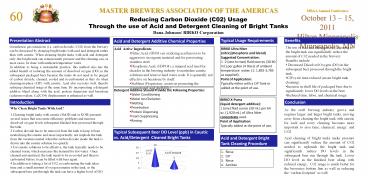MASTER BREWERS ASSOCIATION OF THE AMERICAS - PowerPoint PPT Presentation
1 / 1
Title:
MASTER BREWERS ASSOCIATION OF THE AMERICAS
Description:
Title: PowerPoint Presentation Author: skronmiller Created Date: 5/6/2003 8:39:35 PM Document presentation format: Custom Company: Scientific Societies – PowerPoint PPT presentation
Number of Views:34
Avg rating:3.0/5.0
Title: MASTER BREWERS ASSOCIATION OF THE AMERICAS
1
MASTER BREWERS ASSOCIATION OF THE AMERICAS
60
MBAA Annual Conference October 13 15,
2011Hilton MinneapolisMinneapolis, MN
Reducing Carbon Dioxide (C02) UsageThrough the
use of Acid and Detergent Cleaning of Bright
TanksDana Johnson/ BIRKO Corporation
Presentation Abstract
Typical Usage Requirements
Benefits
Acid and Detergent Additive Chemical Properties
Greenhouse gas emissions (i.e. carbon
dioxide, CO2) from the brewery can be decreased
by cleaning bright tanks with acid and detergent
rather than with caustic. When cleaning bright
tanks with acid and detergent only, the bright
tank can remain under pressure and the cleaning
can, in most cases, be done with ambient
temperature water. In addition to being a
sustainable practice, this method also has the
added benefit of reducing the amount of dissolved
oxygen (DO) in the subsequent packaged
beer because the tanks do not need to be purged
of carbon dioxide, cleaned, cooled
and re-carbonated as they do when
cleaning-in-place (CIP) with caustic. Acid also
recycles well, thereby reducing chemical usage at
the same time. By incorporating a detergent
additive blend along with the acid, protein
dispersion and beerstone (calcium oxalate,
Ca2CO4) displacement is enhanced as well.
- The use of acid and detergent only cleaning of
the bright tank can significantly reduce the
amount of C02 needed in the brewery. Benefits
include - Decreased Dissolved Oxygen (DO) in the
subsequent beer processed through the bright
tank. - CIP cycle time reduced (easier bright tank
cleaning). - Increase in shelf life of packaged beer due to
significantly lower DO levels in the beer. - Reduced time, labor, and chemical usage.
- Acid Active Ingredients
- Nitric Acid, (HN03) an oxidizing acid known to be
aggressive on organic material and for
passivating stainless steel. - Phosphoric Acid, (H3PO4), a mineral acid used for
decades in the brewing industry to neutralize
caustic solutions and remove hard water scale. It
is generally not effective on beerstone by
itself. - Stablizer (Proprietary, assists in promoting the
concentrated acid shelf-life.)
BIRKO Ultra Niter (nitric/phosphoric acid
blend) Suggested Concentration 1 -2 (one-to-two)
fluid ounces (30-60 ml.) per gallon (4 liters) of
ambient temperature water. (1 1,892-3,785 as
supplied). Point of Application Typically either
with a CIP Tank or added at the point of use.
- Detergent Additive Should Provide the Following
Properties - Water Conditioning
- Metal Ion Chelation
- Wetting
- Penetration
- Protein Dispersing
- Foam Suppressing
- Rinsing
BIRKO X-Puma (liquid detergent additive) 1
(one) fluid ounce (30 ml.) per 64 oz. (1,920 ml.)
of Ultra Niter concentrate used. Point of
Application Typically added at the point of use.
Introduction
Conclusion
- Why Clean Bright Tanks With Acid?
- Cleaning bright tanks with caustic (NaOH and/or
KOH) presents several issues that can create
efficiency problems and increase dissolved oxygen
levels subsequent finished beer processed through
the tank. - Carbon dioxide has to be removed from the tank to
keep it from neutralizing the caustic and more
importantly, not implode the tank from the vacuum
created when the carbon dioxide inside the tank
is drawn into the caustic solution too quickly. - For caustic solutions to be effective, the tank
typically needs to be cleaned warm, which
increases the demand for hot water. Once cleaned
and sanitized, the tank needs to be re-cooled and
then re-carbonated before it can be filled with
beer again. - In addition to taking a lot of C02,
re-carbonating the tank takes time and a small
amount of oxygen remains in the tank, so the
subsequent beer put through the tank can have a
higher level of DO.
As the craft brewing industry grows and requires
larger and larger bright tanks, moving away from
cleaning the bright tank with caustic for each
and every cleaning becomes more important to save
time, chemical, energy, and CO2. Acid cleaning
of bright tanks under pressure can significantly
reduce the amount of CO2 needed to replenish the
bright tank and significantly reduce DO levels in
the subsequent beer run through the tank. Lower
DO level in the finished beer along with reduced
energy, C02 usage is much better for the
breweries bottom line as well as reducing the
carbon footprint as well.
Typical Subsequent Beer DO Level (ppb) in Caustic
vs. Acid/Detergent Cleaned Bright Tanks
Acid and Detergent Bright Tank Cleaning Procedure
- Rinse
- CIP
- Rinse
- Sanitize































